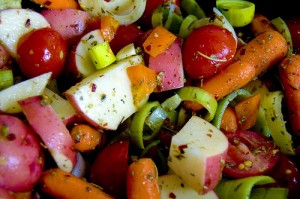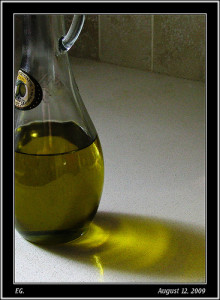by Michelle Sutton-Kerchner
Eat to combat inflammation. Here’s how …
Many painful conditions are exacerbated by inflammation. You’ve heard of a “flare-up,” whether in reference to an old sports injury or arthritis-provoking weather. Pain happens to the best of us, regardless of size, fitness level, or age. As humans, part of our journey is to experience hurt.
Pain is often a response to inflammation. The relationship is scientifically well established. Hence, the crowd of anti-inflammatory medications rallying for our attention on the store shelf. No one wants to be part of that competition when a headache is throbbing or a bum knee is sore. Rather, peruse your grocery store for some relief. Foods that possess anti-inflammatory properties have a safe place in pain management, often with healthy “side-effects.”
Fiber

Findings earlier this year indicate fiber’s benefit in combating inflammation is stronger than previously believed. Studies revealed a reduced C-reactive protein (CRP) in those who consumed fiber, both through food and supplements. The CRP level indicates the amount of inflammation found in the blood. High levels signal general inflammation, which could be a sign of arthritis, heart disease, or a basic infection the body is fighting.
Another study showed men who increased fruit and vegetable consumption from two to eight servings daily lowered CRP levels by one-third. Is this the result of increased fiber or being too full for processed junk food? Perhaps both.
For overall health, slowly increase fiber in your everyday diet. Soluble fiber can help lower cholesterol and glucose levels, which decreases your risk of heart disease and diabetes. Top choices: oats, peas, citrus fruit, apples, carrots, beans, and barley. Insoluble fiber helps digestion and prevents constipation. Top choices: whole wheat flour, wheat bran, cauliflower, green beans, potatoes, beans, and nuts.
Regularly consume dark green and brightly colored vegetables and berries. In addition to their fiber content, blueberries and strawberries are packed with anti-inflammatory phytochemicals and antioxidants. Pomegranates may also provide relief from chronic inflammatory conditions, such as osteoarthritis.
Omega-3 Fatty Acids
 Omega-3 essential fatty acids are tireless in their powers, this time as anti-inflammatory agents. Snack on walnuts, flax seeds, and pumpkin seeds. Eat more cold-water oily fish. Cook with olive oil, rice bran oil, grape seed oil, and walnut oil.
Omega-3 essential fatty acids are tireless in their powers, this time as anti-inflammatory agents. Snack on walnuts, flax seeds, and pumpkin seeds. Eat more cold-water oily fish. Cook with olive oil, rice bran oil, grape seed oil, and walnut oil.
Recent studies revealed a compound found in virgin olive oil inhibits activity of an enzyme associated with inflammation and cancer development. An added benefit, it also is connected with decreased blood pressure and weight loss. Find ways to substitute butter with this flavorful option. Choose virgin or extra-virgin options to assure the oil hasn’t been processed with heat or chemicals, which removes healthy compounds. Although it is olive oil, it’s still not healthy to fry foods. Health benefits were negated in fish containing omega-3 fats once it was fried.
A review in American Family Physician cited three grams of omega-3s daily as effective in relieving morning stiffness and joint swelling or tenderness in those with rheumatoid arthritis.
Protein
Protein builds healthy body tissue. Enjoy lean poultry, fish and seafood, nuts, legumes, and seeds. Soybeans and tofu are also good protein sources. Try to minimize red meat consumption. Protein from dairy sources delivers the two-fer with its calcium and vitamin D content. Be sure dairy is the low-fat variety.
Teas
Their high antioxidant concentration makes tea an anti-inflammatory beverage of choice. Antioxidants protect the body’s cells, which are at risk for damage from elevated levels of inflammation. Rooibos tea is packed with antioxidants, yet not often offered at a local cafe or friend’s kitchen. Green, oolong, and white teas are more commonplace and also effective at treating pain. Sip throughout the day and be soothed.
Spices
Curry and ginger are natural anti-inflammatories. Turmeric is touted by many experts as containing the most powerful anti-inflammatory naturally available. A spice native to India, it contains a high concentration of curcumin.
The journal Alternative Medicine Review reports curcumin may have the power to relieve inflammatory conditions like Crohn’s disease and irritable bowel syndrome. Perhaps gastrointestinal benefits are difficult to imagine, given the often spicy nature of foods seasoned with Indian spices. Another way science continues to discover the unlikely! Curcumin also may help protect against cancer.
Using these spices to flavor food is helpful. Consider taking curcumin in supplement form to obtain enough for significant pain management.
Capsaicin, the chemical that makes jalapeño peppers hot, is a strong anti-inflammatory agent. It inhibits the inflammatory process from transmitting pain signals to the brain. Research indicates capsaicin as a future treatment for arthritis. It also helps a host of other health issues, including migraines, sinusitis, and prevention of certain cancer and cardiovascular diseases. An added perk: In the quest for a healthy weight, jalapeños are considered a highly thermogenic food, which helps burn calories and fat.
Foods to Avoid
One of America’s biggest diet downfalls is the elevated consumption of omega-6 fatty acids (omega-3s’ evil cousin). The omega-6 fats are found in processed and fast food. A diet high in omega-6 and low in omega-3 triggers inflammation, according to a study in Psychosomatic Medicine. Along with subjecting yourself to increased sodium and unpronounceable ingredients, you also build up inflammation in your body. How ironic — fast food that makes you sluggish.
Minimize consumption of highly processed foods, including high-fat meat like bacon, sausage, and lunchmeat, as well as red meat. Reduce consumption of baked goods and pasta that contains refined white flour. Go for whole grains. Decrease sugar by eliminating soda and sweetened cereal. Try healthy versions of your favorite desserts and save candy and pastries for an occasional small treat.
The cakes, cookies, and creamy pasta dishes often craved during times of discomfort may actually contribute to your need for soothing. Find comfort in the form of a hot bath or shower, a relaxing walk, or a warm heating pad. Have a piece of dark chocolate, but pair it with herbal tea. Indulge without causing further consequences.
Weight Control

An anti-inflammatory diet is usually not intended for weight loss. However, healthy eating for life often results in loss of excess weight. Replacing trans fats, highly processed foods, and other food “products” with increased fiber and omega-3s will have a slimming effect. And, a healthy body weight is one of the best defenses against inflammation and its effects.
Unhealthy weight is the cause of countless health problems, inflammation included. There is a direct link between conditions that cause chronic pain and excessive body weight. Arthritis is one example.
“The heavier you are, the more likely you are to get arthritis,” according to Patience White, MD, chief public health officer for the Arthritis Foundation. Combined with a regular exercise program, an anti-inflammatory diet can help treat and prevent arthritis by maintaining a healthy body weight.
Along with the goal of reducing pain, anti-inflammatory diets continue to be investigated for their benefits against heart disease, diabetes, and other conditions. The pain-relieving results won’t be immediate as found with ibuprofen or other medications. It may take up to three weeks to notice an improvement. However, instead of four to six hours of relief, the results tend to be long-term. Think: Lifelong improvement. Eat well. Feel well.
Sources
“6 Anti-Inflammatory Foods to Try,” by Jennifer Acosta Scott at www.everydayhealth.com.
“Anti-Inflammatory Diet: Road to Good Health?” by Kathleen Doheny at www.webmd.com.
“More Fiber, Less Inflammation?” at www.arthrtitistoday.org
“Nutrition and Health: Anti-Inflammatory Foods,” by Shereen Jegtvig at www.about.com.
Images
Spices (introductory photo): http://www.flickr.com/photos/vinni/4326912551/
Veggies: http://www.flickr.com/photos/saucysalad/4700823567/
Olive oil: http://www.flickr.com/photos/37873897@N06/3814726474/
 Fitness & Wellness News Your Source for Fitness News, Wellness News, Health News, and Nutrition News!
Fitness & Wellness News Your Source for Fitness News, Wellness News, Health News, and Nutrition News!




